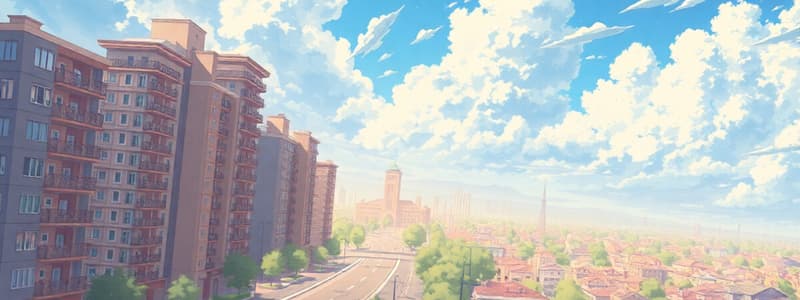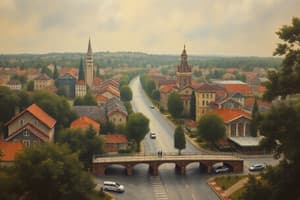Podcast
Questions and Answers
What phenomenon describes the movement of retail and commercial activities away from the urban center?
What phenomenon describes the movement of retail and commercial activities away from the urban center?
- Edge cities
- Gentrification
- Suburbanisation (correct)
- Urban decay
Which term is used to describe the decline of Central Business Districts (CBDs) in relation to population movement?
Which term is used to describe the decline of Central Business Districts (CBDs) in relation to population movement?
- Suburban flight (correct)
- Edge development
- Deindustrialisation
- Urban sprawl
What was a significant factor contributing to the decline of many Western cities in the second half of the 20th century?
What was a significant factor contributing to the decline of many Western cities in the second half of the 20th century?
- Urban gentrification
- Deindustrialisation (correct)
- Increased tourism
- Globalisation
What coalition is formed by local governments, bankers, financiers, and developers aimed at revitalising the CBD?
What coalition is formed by local governments, bankers, financiers, and developers aimed at revitalising the CBD?
Which strategy is NOT typically associated with the revitalisation of downtown areas?
Which strategy is NOT typically associated with the revitalisation of downtown areas?
What does the 'back to the city' movement emphasize?
What does the 'back to the city' movement emphasize?
Which of the following is a notable theme of downtown change identified by Larry Ford?
Which of the following is a notable theme of downtown change identified by Larry Ford?
What economic strategy involves creating new housing and liveliness in urban areas?
What economic strategy involves creating new housing and liveliness in urban areas?
What was a significant change in urban structure in the shift from monocentric to polycentric cities?
What was a significant change in urban structure in the shift from monocentric to polycentric cities?
The decline of CBDs in the US started in the 1980s.
The decline of CBDs in the US started in the 1980s.
What role did deindustrialization play in urban decline?
What role did deindustrialization play in urban decline?
Gentrification is when higher income groups move into and revitalise older working class neighbourhoods that have experienced __________.
Gentrification is when higher income groups move into and revitalise older working class neighbourhoods that have experienced __________.
Which of the following strategies is NOT mentioned for revitalizing CBDs?
Which of the following strategies is NOT mentioned for revitalizing CBDs?
What is a megalopolis?
What is a megalopolis?
Suburbanisation was mainly fueled by increased access through a network of bicycles.
Suburbanisation was mainly fueled by increased access through a network of bicycles.
What is the purpose of City Improvement Districts (CIDs) in South Africa?
What is the purpose of City Improvement Districts (CIDs) in South Africa?
What does the 'back to the city' movement emphasize?
What does the 'back to the city' movement emphasize?
Flashcards are hidden until you start studying
Study Notes
From Monocentric to Polycentric Cities
- Cities are transitioning from a single-center (monocentric) structure to a multi-center (polycentric) structure.
- Decentralization and suburbanization are driving forces behind this shift.
- Edge cities, like Sandton, have emerged as new economic and commercial hubs.
The Decline of Central Business Districts (CBDs)
- The decline of CBDs started in the 1950s in the US and the 1980s in South Africa.
- This decline is linked to the suburbanization of middle and upper-income residents.
- Retail and commerce followed, resulting in higher vacancy rates, plummeting property values, and a shrinking tax base.
- Deindustrialization also contributed to the decline of many Western cities in the latter half of the 20th century.
- Inner cities became areas with high crime rates, poor maintenance, and a concentration of urban poverty and marginalized groups.
Revitalization and Regeneration Efforts
- Attempts to revitalize inner cities started in the US in the late 1960s.
- In South Africa, urban regeneration initiatives emerged in the 1990s.
- Urban growth machines, composed of local governments, bankers, financiers, developers, and planners, seek to restore CBD prosperity.
- City Improvement Districts (CIDs) have been established in South Africa.
Strategies for CBD Revitalization
- Strategies for revitalizing CBDs include:
- Historic preservation of architecture and heritage sites.
- Development of downtown housing projects.
- Leveraging creative and cultural industries.
- Promoting nightlife and entertainment (night-time economy).
- Utilizing tourism, including Disneyfication.
- Hosting major events, conferences, and conventions.
- Developing sports events and facilities.
Themes of Downtown Change
- Larry Ford (2003) identifies four major themes of CBD change:
- Fun zones: Creating entertainment and leisure districts.
- Historic districts: Preserving and showcasing historical sites and architecture.
- Residential neighbourhoods: Encouraging urban living through the "back to the city" movement and gentrification.
Urban Land Use, The CBD, and Suburbs
- The shift from a monocentric to a polycentric city, spurred by decentralization and suburbanization, has resulted in the emergence of edge cities (e.g., Sandton).
- This shift can also contribute to the decline of Central Business Districts (CBDs), as retail and commercial activities move away from the center.
- This trend began in the US in the 1950s and in South Africa in the 1980s.
- Middle and upper-income individuals leaving inner-city neighborhoods for suburbs take their purchasing power with them, leading to a decline in CBD retail and commerce.
- This results in higher vacancy rates, plummeting property values, and a shrinking tax base.
- The decline of many Western cities in the late 20th century was also impacted by deindustrialization.
- Inner cities became spaces with high crime rates, poor maintenance, and concentrated poverty and marginalized groups.
- In the late 1960s, efforts to revitalize or regenerate inner cities began in the US.
- South Africa has seen urban regeneration efforts since the 1990s.
- Urban growth machines, consisting of local governments, bankers, financiers, real estate developers, and planners, work together to revitalize CBDs.
- In South Africa, City Improvement Districts (CIDs) have been established to achieve this goal.
- Strategies for CBD revitalization include:
- Historic preservation: including architectural preservation and heritage sites.
- Downtown housing developments: promoting residential living in the city center.
- Creative and cultural industries: leveraging the arts and culture to attract residents and visitors.
- Nightlife and entertainment: Building a strong nightlife and entertainment scene.
- Tourism: Attracting tourists through "Disneyfication" of public spaces.
- Major events and convention centers: Hosting large-scale events and conferences.
- Sports events and facilities: Using sports venues to revitalize areas.
- Larry Ford (2003) has identified four major themes of downtown change:
- Fun Zones: creating entertainment-focused areas.
- Historic Districts: preserving and promoting historic spaces.
- Residential Neighborhoods: encouraging urban living through initiatives like the "back to the city" movement and gentrification.
- Gentrification has played a crucial role in reshaping inner cities.
- Gentrification involves higher-income groups moving into and revitalizing older, working-class neighborhoods that have experienced disinvestment.
- This process can lead to the displacement of lower-income residents.
Suburban Changes
- Suburbanization was driven by increased access to private transportation through freeway networks.
- This has produced polycentric cities with multiple cores or nodes, often centered around large regional shopping malls.
- Suburban growth includes office and industrial parks.
- Suburban expansion has posed challenges for infrastructure and planning.
- Urban sprawl, the continuous outward growth of cities, raises sustainability concerns.
- Urban sprawl can lead to the merging of cities, creating conurbations.
- The merger of several cities into a vast urban corridor forms a megalopolis.
Studying That Suits You
Use AI to generate personalized quizzes and flashcards to suit your learning preferences.




